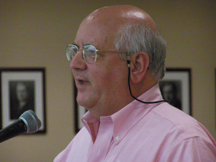Trying to put the last of the pieces together for a complicated mall project in a significantly negative economic environment, the Cameron Urban Renewal group – with the approval of the Bayonne City Council – secured a $2.5 million low-interest loan to help with construction costs.
The loan – which would be paid back over a seven-year period – is being financed by the Bayonne Urban Enterprise Zone at 2 percent interest.
This would be the first time the UEZ is financing a loan. But according to Michael O’Connor, executive director of the Bayonne Economic Development Corporation, the move is in the UEZ’s self interest since the mall would generate a minimum of $1.5 million in additional revenue to the UEZ once fully operational.
Legislation signed into law in January 2002 that created the Bayonne UEZ allows businesses to charge 3 1/2 percent sales tax and gives businesses a variety of incentives for becoming members. Funds collected from the discounted sales tax will remain in the zone to finance local projects.
O’Connor said the mall is an $84 million project, which has been inching along toward completion for more than four years.
Often called a “power center,” the mall is to be located on Route 440 between East 22nd Street and New Hook Road. Cameron was to subdivide several strips of land that would create a single 29-acre block of land to accommodate a 360,000 square foot shopping mall.
Originally scheduled to open for business in the fall of 2007, the mall suffered several set backs, including the loss of Circuit City electronic store – which went out of business last year.
“Cameron Group is very close to signing a lease with a second anchor store to replace Circuit City,” O’Connor said.
Already signed are Lowe’s Home Improvement Center, a New York Sports Club, a Longhorn Steak House and, possibly, a Starbucks Coffee.
The Bayonne Local Redevelopment Authority – which has control over the 30-acre redevelopment site – voted last year to apply to the New Jersey Environmental Infrastructure Trust for a loan of more than $19 million for a stormwater management system for the mall.
The project is expected to create about 800 jobs, not including construction jobs, and the city is expected to see up to $1.2 million in additional tax revenues and as much as $4 million in revenue to the Urban Enterprise Zone.
O’Connor said a rise in construction costs has helped to delay the project, but did not stop the project.
He said the New Jersey Economic Development Authority also approved a $1 million Smart Growth loan that will help cover some of the preconstruction costs, with more state funds likely once construction actually starts.
“This project will generate at least 1,200 union construction jobs over the 18 months to two years of building and the equivalent of 800 full time jobs once it is completed,” he said. “This is one of the few projects of this scale under construction in New Jersey this year.”
Orphaned bridge decaying
The City of Bayonne is appealing a decision that rejects the use of Department of Transportation funds for the repair of a pedestrian bridge over the rail tracks at 25th Street.
Called “an orphan bridge,” the span connects Avenue E with Prospect Avenue, but has been falling apart for years.
The city agreed to repair the bridge a year ago when it could not be determined whether the CSX rail, the Hudson-Bergen Light Rail, or some other entity was responsible for it.
The city applied and received a $300,000 state Department of Transportation grant to fix it earlier this year. But since then, nothing has been done. The estimated cost for the repair is $494,000.
Stan Marko – a resident who uses the bridge frequently – said the bridge is in terrible condition, with gaps in the concrete as well as infestations of wasps that make using it hazardous.
Terrence Malloy, the city’s chief financial officer, said the city is ready to repair the bridge. But the state has said the bridge must be rebuilt to meet contemporary disability access standards – which means any upgrade would require the installation of an elevator and the reconfiguration of the bridge so that it is less steep. This, according to Malloy, raises the cost of fixing the bridge into millions of dollars.
Under state law, the city could make repairs to the bridge as along as the repairs fall under 40 percent of the reconstruction. The city claims the bridge repair falls under this. The state disagrees.
“We’re appealing the decision,” Malloy said.
Marko, however, asked if the city might do temporary repairs to provide some measure of safety.
Councilman Terrence Ruane said that in his role with the post office, he frequently used the bridge.
“I took a tour and I was shocked by what I saw,” he said, encouraging the city to perform some maintenance until the overall issue can be resolved.
In another matter, Patricia Mulligan, who had complained previously about a weed-infested area near Fifth Street and Route 440, thanked the city’s Public Works Department for cleaning up the area.
Also in citizens’ remarks, former police officer Leonard R. Kantor asked why properties with more than one building are not being assessed at a higher rate than properties with single structures. He also cautioned the City Council about the impact the revaluation will have on local residents, citing property he owns in southern New Jersey whose assessment more than doubled.
